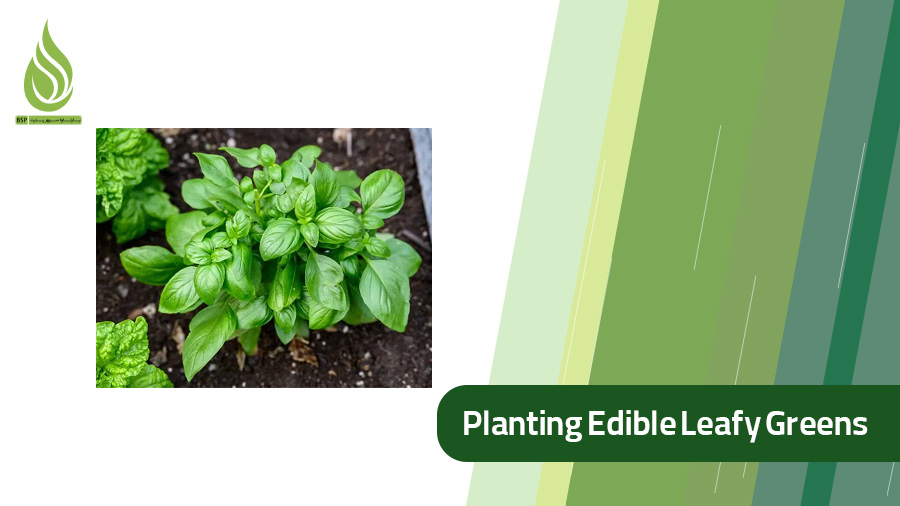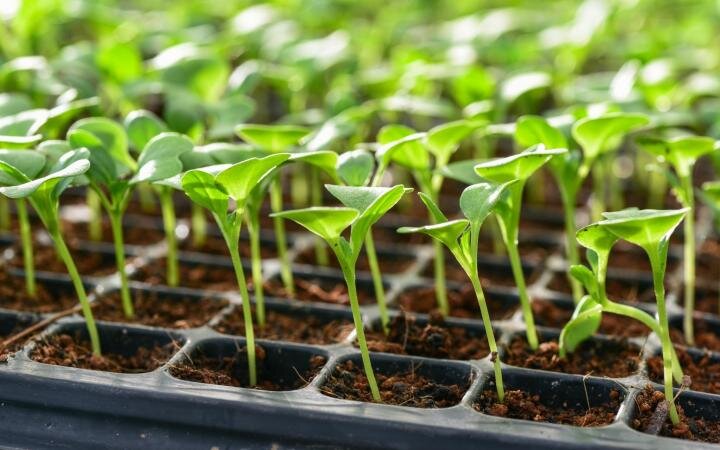
Best Time & Conditions for Planting Edible Leafy Greens
Consuming edible leafy greens is a common practice at Iranian dining tables. If you intend to cultivate leafy greens in a garden, balcony, or small plot, understanding the ideal planting time is crucial. Planting leafy greens at the right time ensures they benefit optimally from sunlight, moisture, and temperature, promoting robust growth. This fosters quality plant development and, in turn, results in a more bountiful harvest. This article explores the optimal times for planting edible leafy greens and scrutinizes the factors that impact their growth positively.
What Factors Affect Leafy Greens Planting?
Several factors are crucial in planting leafy greens:
- Temperature: Each vegetable requires a specific temperature range for optimal growth. Cold-season vegetables like lettuce thrive in cooler temperatures, while warm-season vegetables like basil need higher temperatures to flourish.
- Sunlight: Vegetables need sufficient light for photosynthesis. Planting should be timed to ensure plants receive an adequate amount of sunlight for growth.
- Soil Quality: Rich and fertile soil provides the best conditions for growth. Before planting, soil pH and composition should be checked, and necessary nutrients should be added if needed.
- Soil Moisture: The soil must be adequately moist. Planting seeds in dry soil can prevent germination.
- Type of Vegetables: Understanding the types of vegetables and their specific requirements is essential for maximizing productivity.
- Weather Forecast: Monitoring rainfall and weather conditions in the coming days helps determine the best planting time. Being aware of sudden temperature changes can significantly impact the timing of planting.

Time and Conditions for Planting Leafy Greens
Let’s take a look at the best times and conditions for planting each of these edible leafy greens:
- Leek
- Planting Time: Early spring and fall
- Conditions: The soil should be rich and well-drained. Leek requires full sunlight and regular watering for healthy growth.
- Basil
- Planting Time: Spring
- Conditions: Basil thrives in warmth and ample sunlight. The soil should be fertile with good drainage. Regular watering and preventing soil dryness are essential.
- Garden cress
- Planting Time: Spring and fall
- Conditions: Garden cress grows better in moist and cool soil. It needs direct sunlight and regular watering to prevent soil dryness.
- Mint
- Planting Time: Spring and fall
- Conditions: Mint grows in moist soil with partial shade. Regular watering and preventing soil dryness are important.
- Cilantro
- Planting Time: Spring and fall
- Conditions: Cilantro thrives in well-drained soil with full sunlight. Regular watering is necessary to prevent soil dryness.
- Tarragon
- Planting Time: Spring
- Conditions: Tarragon needs well-drained and rich soil. It requires full sunlight and grows better in warm conditions. Regular watering is crucial to maintain soil moisture while avoiding waterlogging.
- Parsley
- Planting Time: Spring and fall
- Conditions: Parsley grows in rich, moist soil with either sunlight or partial shade. Regular watering and preventing soil dryness are vital for its growth.

- Marjoram
- Planting Time: Spring
- Conditions: Marjoram needs well-drained and rich soil. It requires full sunlight for optimal growth and thrives best in warm conditions. Moderate climates are suitable for its growth, but cold weather is not ideal for this herb.
- Garden radish
- Planting Time: Spring and fall
- Conditions: Garden radishes thrive in loose, well-drained soil with a pH of 6.0 to 7.0, require at least 6 hours of sunlight daily, need regular watering to keep the soil moist, and prefer cooler temperatures between 50°F to 70°F (10°C to 21°C) to avoid becoming woody or bolting.
- Chives
- Planting Time: Spring and fall
- Conditions: Chives thrive in rich soil with good drainage. They require full sunlight but can also tolerate partial shade. Regular watering, especially during warm periods, is crucial for maintaining soil moisture for chives’ growth.
- Pennyroyal
- Planting Time: Spring and fall
- Conditions: Pennyroyal thrives in well-drained, loamy soil with a pH of 6.0 to 7.0, prefers full sunlight but can tolerate partial shade, requires regular watering to keep the soil moist without being waterlogged, and grows best in moderate temperatures between 60°F to 75°F (15°C to 24°C).
Cold-Loving Vegetables: Cold-tolerant vegetables can withstand chilly weather and are best grown during colder seasons. These veggies can be planted in the garden as winter approaches. Typically, these vegetables have small stature and shallow roots. Examples include mint, coriander, parsley, dill, chives, and lettuce.
Warm-Weather Vegetables: Vegetables that thrive only in warmer seasons have larger size and deeper roots. Plants like cucumbers, tomatoes, pumpkins, etc., prefer warmer climates. Most leafy greens can grow even in the colder months. However, basil, tarragon, and marjoram are more sensitive to cold and are better off planted in spring.
Fertilization of Edible Greens
Proper nutrition and fertilization are essential for the growth and quality of leafy greens. The soil for planting leafy greens should be rich in organic matter and have good drainage. Using compost or garden soil can improve soil quality by providing essential nutrients for vegetables and enhancing soil structure. Animal manure can also be a good source of nutrients, but it should be well-decomposed before use.
To ensure soil fertility, it’s advisable to use mineral fertilizers along with organic ones. For optimal growth of vegetables, the best fertilizer is NPK fertilizer, containing Nitrogen (N), Phosphorus (P), and Potassium (K) crucial for plant growth. Organic and mineral fertilizers should be added to the soil during soil preparation before planting. Adequate watering is essential after fertilization. NPK fertilizer should be applied at the beginning of the growing season and after each harvest. It can be applied by sprinkling on the soil or mixing it with the soil.
In general, leafy greens like basil, parsley, coriander, etc., require Nitrogen for growth. Nitrogen promotes leafy growth and ensures the greenness of the leaves. For root vegetables like radishes and onions, Phosphorus should be used as it aids in root growth. If the greens turn yellow, it may indicate a need to adjust the soil pH or fertilize the soil. For alkaline and saline soils, sulfur-based fertilizers like ammonium sulfate can help reduce alkalinity. In acidic soils, lime can be used to increase the soil pH to some extent.
Ammonium sulfate fertilizer should be used at the beginning and throughout the growing season. It can be applied by sprinkling on the soil and mixing it with the soil.

Important Tips for Growing Leafy Greens
For successfully planting and growing leafy greens, it’s essential to follow these tips:
- Choose the Right Location: Leafy greens generally need full sunlight, which means around 6 to 8 hours a day. Make sure the planting area is well-ventilated and away from pollution sources.
- Soil Quality: Use nutrient-rich soil with a controlled pH level (around 6 to 7) for better growth. Ensure the soil has good drainage to prevent waterlogging.
- Watering: Leafy greens require regular moisture. Water the plants so that the soil stays moist but doesn’t become waterlogged. The best times to water are early in the morning or in the evening. When watering, aim to water the base of the plants rather than splashing water on the leaves.
- Use Fresh, Reliable Seeds: Fresh and high-quality seeds have a higher germination rate. Purchase seeds only from reputable stores.
- Spacing: Maintain proper spacing between plants to allow them to grow well and reduce competition for light and nutrients.
- Pest and Disease Control: Regularly check plants for pests and diseases and take quick action to address any issues. Using organic pesticides can help reduce pests.
- Protective Covers: It’s advisable to use plastic or fabric covers to protect plants from cold weather and heavy rain.
- Seed Quantity: Generally, you should plant about 3 to 5 grams of seeds per square meter.
- Air Circulation: Mixing garden soil with compost is the best option for growing leafy greens. Before planting, be sure to turn the soil well with a shovel or trowel.
- Planting Seeds directly or using the Transplanting method: You can plant leafy greens either from seeds or using the transplanting method. If you live in a colder area, you can plant seeds in a warm greenhouse and then transplant the bushes to the main garden once they sprout. This method is often used for basil and other warm-weather greens.
- Soaking Seeds: Before planting, soak the seeds for 24 hours and then spread them out on a clean towel.
- Planting in Pots: People living in apartments can grow leafy greens in pots. Your pot should be about 15 centimeters tall to allow the roots to grow properly. Place about ten seeds in each pot and cover them lightly with some compost. Do this gently to avoid moving the seeds around. Finally, use a spray bottle to moisten the seeds.
